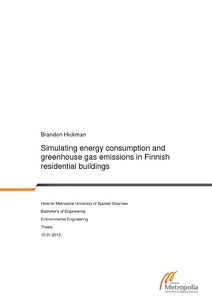Simulating energy consumption and greenhouse gas emissions in Finnish residential buildings
Hickman, Brandon (2013)
Hickman, Brandon
Metropolia Ammattikorkeakoulu
2013
Julkaisun pysyvä osoite on
https://urn.fi/URN:NBN:fi:amk-201302052089
https://urn.fi/URN:NBN:fi:amk-201302052089
Tiivistelmä
Global warming is an ever increasing problem and greenhouse gas emissions from anthropogenic sources are on the rise. Residential buildings account for a nearly a fifth of the energy consumption in Finland. In order to properly understand the different factors effecting energy consumption and the consequent greenhouse gas emissions were simulated for a district in Tampere. Simulation is an important method to see the effects of different actions without the need for field testing. Three different scenarios were also tested to determine the outcome of different actions to reduce energy consumption and emissions. The first scenario was replacing the heating sources in direct electrically heated detached homes with wood heating, the second scenario was installing heat pumps into every home that used direct electrical heating and third was to test the effect of different internal temperatures on every house’s heat consumption. The results show that the apartment building are the greatest net consumer of energy and producer of emissions, but the energy and emission intensity is largest for detached and attached homes. The most successful method of reducing emission was scenario one. Scenario three was the best scenario to reduce total energy consumption. These results have a wide range of practical application such as city planning, individual user’s energy decisions and predicting nationwide greenhouse gas emissions.
